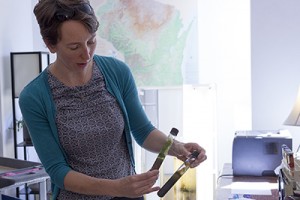What if you could travel back in time 3 billion years, and take a breath? What would earth’s air smell like?
Deeply stinky, according to Brooke Norsted, an outreach specialist for the University of Wisconsin-Madison Geology Museum.
Drawing on input from UW-Madison geoscientists about the organic and chemical compounds present at that time, Norsted has concocted an aroma she believes comes pretty close to the volcanic and microbial stew of early earth.
Visitors to a new exhibit, “Biosignatures: What Does Life Leave Behind?” created by Norsted and Museum Director Richard Slaughter, can get a whiff by lifting the cap of a display labeled “Aromas of Astrobiology.” Inside: a vial of aroma beads Norsted special-ordered from a California company that supplies custom-made smells to museums, stores, and eateries.
“I asked them for all the stinky smells: damp earth, decay, urine, volcano ash,” Norsted says. “Physical phenomena like sea vents still exist, so it wasn't too hard to construct an odor for that one.”
Set to open to the public Sept. 26 to coincide with the start of the 2013 Wisconsin Science Festival, “Biosignatures” aims to excite public curiosity about astrobiology research at UW-Madison.
Research sponsored by the NASA Astrobiology Institute, which funds the Wisconsin Astrobiology Research Consortium and other teams, is developing new tools and methods for detecting evidence of past life, which in turn may provide clues for recognizing signs of life or the precursors to life in other places, such as Mars or even Titan, Saturn’s largest moon. The Wisconsin consortium, led by Vilas Distinguished Professor of Geoscience Clark Johnson, received its second major grant from NASA in 2012.
The exhibit’s creative displays about astrobiology will go a long way toward getting some difficult concepts across, says Johnson.
“The record of early life on Earth and Mars won’t be big dinosaur bones — life would have been microbial, and so the evidence often lies in indirect things such as a unique chemical signature,” says Johnson. “We were looking for a display that would be remembered, and smells are certainly something many people do not forget.”
— Clark Johnson, Vilas Distinguished Professor of Geoscience
In the earth’s violent early days, during which meteorite impacts produced hurricane-force winds and 1,000-foot tsunamis, primitive bacteria were forming and dying, laying a chemical trail that survives in ancient rocks. Johnson’s group is focused on very early iron-based microbial metabolisms. These processes are recorded in major iron deposits around the world, including the Lake Superior region. Few people realize, Johnson says, that the metal used in everyday life — including that mined in the Upper Midwest — was concentrated by microbial processes 2.5 to 3 billion years ago.
“That is kind of amazing, when you think about it,” he says.
Sulfides were important to “chemolithotrophic” organisms (those that use inorganic chemicals for energy) such as the iron-processing microbes, which existed before the oxygenic photosynthesis we know today — thus contributing some rotten-egg aroma to “early earth.”
On the other hand, Titan smells pretty sweet. Turns out the largest moon of Saturn is blanketed with cyanide dust, which smells like burnt almonds. (Norsted is quick to point out that visitors aren't actually smelling cyanide, just aroma-infused beads).
Other exhibit highlights include:
- A homemade microbial community that Norsted has been growing in giant test tubes in her office for the past couple of years (the layers of green and purple slime will continue to change and grow while on display).
- A large sample of “ejecta”– a rock that formed on a single day when a gigantic asteroid (one of the largest to ever to hit the earth) punctured the mantle, vaporized, and spewed across North America.
- A piece of Mars – for this exhibit, the museum acquired a meteorite that was broken off of the “Red Planet” around 700,000 years ago and landed in Morocco in 2011.
With more than 50,000 visitors a year (14,000 Wisconsin schoolchildren get hour-long guided tours), the Geology Museum is the most popular science outreach venue on the UW-Madison campus.
In addition to stewarding collections of some of the earth’s oldest rocks (3.5 billion years or more) and rare fossils such as the Boaz mastodon (a full skeleton discovered in 1897 by boys playing along a creek in Boaz, Wis.), the museum is known for its friendly public persona. When the Packers won the Super Bowl in 2010, for example, museum curator Carrie Eaton made the mastodon an extra-large green and gold jersey to celebrate.
“Biosignatures: What Does Life Leave Behind?” is the largest exhibit mounted by the museum since it erected “Wisconsin’s first dinosaur” (Edmontosaurus) in 1991.
The new exhibit meets with NASA’s approval. Communicating and sharing the discoveries made and knowledge gained from NASA-funded astrobiology research is one of the agency’s key goals, according to Daniella Scalice, education and public outreach lead for the NASA Astrobiology Institute.
“Brooke and her team have always been on the leading edge of innovation in education and outreach projects,” says Scalice. “They deserve full credit for their creative approach.”
